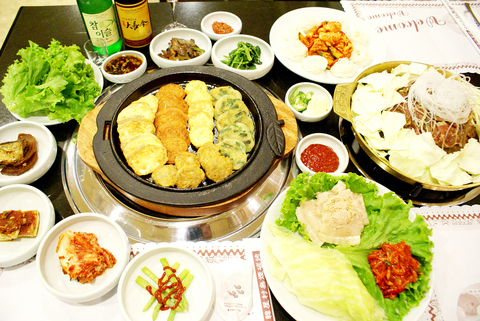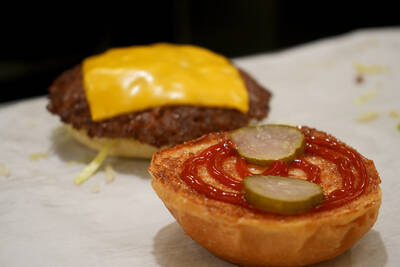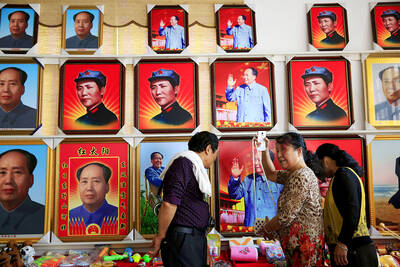Korea House Village (韓屋村)
Address: 3, Ln 105, Shida Rd, Taipei
(台北市師大路105巷3號)

PHOTO: NOAH BUCHAN, TAIPEI TIMES
Telephone: (02) 2364-1980
Open: Daily from noon to midnight
Average meal: NT$1,000 for two, plus 10 percent service charge
Details: Chinese and Korean menu (English menu coming soon)
Proprietors of Korean restaurants in Taiwan often say the food they serve has been changed to suit local palettes, whatever that means. It sounds like some feeble excuse not to put the proper amount of effort into making the pastes and sauces, for which any Korean will tell you is as important as the meat or seafood it's served with, or slicing the meat used for barbecue so thin that it could only grace a hot pot.
Not so with the recently opened Korea House Village. Proprietor Zhao Yi-xian (趙懿憲) is unwilling to compromise authenticity to suite local tastes. Instead, he transplants 10 years of experience operating a restaurant in South Korea, where his mother-in-law grew the peppers and soy beans that go into making the pastes and sauces, to Shida. Three years in the planning, the tableware, the tables and chairs, even the cutlery is imported from South Korea. The walls are lined with tastefully finished traditional Korean art and glass display cases containing expensive ginseng alcohol.
Authentic Korean restaurants are worth a visit if only to sample the free appetizer dishes they serve before the meal. Korea House Village serves up six, and on the day we were there included asparagus, kimchi, pickled eggplant, mackerel and white radish marinated in light soy sauce, tofu in a light soy and ginger sauce topped with green onions and green vegetables marinated in sesame oil. Zhao says that aside from kimchi, the dishes change with the season.
Other specialties on the menu include tempura (NT$250) — a selection of white fish, squash, green onion mini pancakes and kimchi mini-pancakes — that is served with red-pepper paste infused with fresh garlic, hints of ginger and green onions. The exterior of each was crispy with the pancakes chewy on the inside and the fish light in flavor. The octopus and fresh cucumber salad marinated in hot sauce and surrounded by eight noodle nests (NT$300) was zingy.
A good deal for two is the bulgogi (NT$500), or marinated barbecue beef. Served with tofu, noodles, vegetables and seafood on a large iron plate, the mixture is then pan-barbecued and eaten straight up or with fresh lettuce leaves. The menu also offers an extensive selection of grilled barbecue dishes.

Taiwan can often feel woefully behind on global trends, from fashion to food, and influences can sometimes feel like the last on the metaphorical bandwagon. In the West, suddenly every burger is being smashed and honey has become “hot” and we’re all drinking orange wine. But it took a good while for a smash burger in Taipei to come across my radar. For the uninitiated, a smash burger is, well, a normal burger patty but smashed flat. Originally, I didn’t understand. Surely the best part of a burger is the thick patty with all the juiciness of the beef, the

The ultimate goal of the Chinese Communist Party (CCP) is the total and overwhelming domination of everything within the sphere of what it considers China and deems as theirs. All decision-making by the CCP must be understood through that lens. Any decision made is to entrench — or ideally expand that power. They are fiercely hostile to anything that weakens or compromises their control of “China.” By design, they will stop at nothing to ensure that there is no distinction between the CCP and the Chinese nation, people, culture, civilization, religion, economy, property, military or government — they are all subsidiary

Nov.10 to Nov.16 As he moved a large stone that had fallen from a truck near his field, 65-year-old Lin Yuan (林淵) felt a sudden urge. He fetched his tools and began to carve. The recently retired farmer had been feeling restless after a lifetime of hard labor in Yuchi Township (魚池), Nantou County. His first piece, Stone Fairy Maiden (石仙姑), completed in 1977, was reportedly a representation of his late wife. This version of how Lin began his late-life art career is recorded in Nantou County historian Teng Hsiang-yang’s (鄧相揚) 2009 biography of him. His expressive work eventually caught the attention

This year’s Miss Universe in Thailand has been marred by ugly drama, with allegations of an insult to a beauty queen’s intellect, a walkout by pageant contestants and a tearful tantrum by the host. More than 120 women from across the world have gathered in Thailand, vying to be crowned Miss Universe in a contest considered one of the “big four” of global beauty pageants. But the runup has been dominated by the off-stage antics of the coiffed contestants and their Thai hosts, escalating into a feminist firestorm drawing the attention of Mexico’s president. On Tuesday, Mexican delegate Fatima Bosch staged a